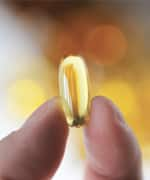Life Extension Magazine®
Aspirin Lowers Risk of Advanced Prostate Cancer | |
According to a new study presented at the American Society of Clinical Oncology Genitourinary Cancers Symposium in San Francisco, men who took greater than three aspirin a week reduced their risk of dying from prostate cancer. In the beginning of the study, the patients were taking a 325 mg dose three times a week; however, later on some patients switched to the 81 mg dose.* Among patients in the early stages of the disease, aspirin helped decrease the risk of developing advanced prostate cancer by 24%. It also lowered the risk of dying from prostate cancer by 39%. In the study, the researchers examined over 22,000 men enrolled in the Physicians’ Health Study, which began in 1982. A total of 3,193 men were diagnosed with prostate cancer over the almost 30-year study. Just over 400 men developed lethal prostate cancer. Lethal prostate cancer was defined as either death from prostate cancer or the spread of prostate cancer to other organs. In addition to alleviating pain and inflammation, aspirin prevents platelets from binding together during the blood clotting process. Because of this, the researchers believe that the common pain reliever may help fight prostate cancer progression by preventing tumor cells from metastasizing to bone. Editor’s Note: “It was after diagnosis of prostate cancer that there appeared to be a benefit,” said study author Christopher Allard, adding that aspirin “doesn’t affect the incidence, but it affects the progression.” |
|
| Reference | |
*American Society of Clinical Oncology Genitourinary Cancers Symposium in San Francisco, Jan 7-9, 2016. |
|
Breast Cancer Risk Linked to High-Sugar Diet | |
A new study published in Cancer Research claims that a diet high in sugar may increase the likelihood of breast cancer as well as hasten the spread of the disease to the lungs.* Study co-author Lorenzo Cohen and colleagues set out to assess how sugar intake influenced breast cancer development in mice that were randomized to various diets, including a sucrose-enriched diet, a fructose-enriched diet, and a starch-control diet. According to the researchers, the amount of sucrose and fructose the mice consumed was comparable to that found in a typical Western diet, characterized by a high intake of refined sugars, saturated fat and red meat, and a low intake of fresh fruits, vegetables, and whole grains. Compared with mice fed the starch-control diet, those fed the sucrose- and fructose-enriched diets were more likely to develop breast cancer. The team found 30% of the mice fed the starch-control diet had breast cancer tumors at 6 months of age, compared with 50% to 58% of mice fed the sucrose-enriched diet. The researchers found that the mice fed a sucrose- or fructose-enriched diet had significantly more tumors on the lungs than those fed the starch-control diet, suggesting high sugar intake speeds up breast cancer metastasis. The team found that dietary fructose and sucrose increased 12-lipoxygenase (12-LOX) signaling, which increased production of 12-hydroxy-5Z,8Z,10E,14Z-eicosatetraenoic acid (12-HETE) to raise the risk of breast cancer development and metastasis. Editor’s Note: “We determined that it was specifically fructose, in table sugar and high-fructose corn syrup, ubiquitous within our food system, which was responsible for facilitating lung metastasis and 12-HETE production in breast tumors,” said Professor Cohen, of the University of Texas MD Anderson Cancer Center. |
|
| Reference | |
*Canc Res. 2016 Jan 4. |
|
Low Vitamin D Levels Linked to Increased Leukemia Rates |
|
On December 4, 2015, PLOS One reported the findings of an increased risk of leukemia in environments with a lower level of ultraviolet B (UVB) irradiance, which reduces the amount of vitamin D manufactured by the body.* The researchers utilized leukemia incidence rates from the International Agency for Cancer Research and cloud cover data from the NASA International Satellite Cloud Climatology Project for 172 countries. They found a correspondence between higher leukemia rates and residence in countries closer to the poles, including Australia, the United States, Ireland, Canada, and New Zealand, while equatorial countries, including Bolivia, Nigeria, and Samoa had lower rates. “These results suggest that much of the burden of leukemia worldwide is due to the epidemic of vitamin D deficiency we are experiencing in winter in populations distant from the equator,” commented co-author Cedric Garland, DrPH. Editor’s Note: “People who live in areas with low solar ultraviolet B exposure tend to have low levels of vitamin D metabolites in their blood,” Dr. Garland explained. “These low levels place them at high risk of certain cancers, including leukemia.” |
|
| Reference | |
*PLOS One . 2015 Dec 4. |
|
Walnuts Have 21% Fewer Calories than Previously Believed | |
A new study published in the Journal of Nutrition found that a 1-ounce (or 28.35 grams) serving of walnuts has 146 calories, or 21% fewer than the 185 calories listed in the USDA Nutrient Database.* The calorie value for walnuts was traditionally determined using the 19th century Atwater factors system, which calculates metabolizable energy (ME), or energy available to the body, for many foods. The study, led by Dr. David J. Baer at the US Department of Agriculture, used the bomb calorimetry method to calculate calories of walnuts metabolized by the study participants. In the study, the research team looked at 18 healthy adults. Each was randomly assigned a sequence of two diets: a controlled American diet without walnuts for a three-week period and a controlled diet with 1.5 servings of walnuts (42 grams) for another three-week period. Total calorie levels were consistent for individual participants across both treatment periods. Administered diets, walnuts, and fecal and urine samples were collected and subject to bomb calorimetry to measure calories, and the resulting data were used to calculate the metabolizable energy of the walnuts. Editor’s Note: “Given the potential health benefits of consuming walnuts, including the reduced risk for cardiovascular disease, it is worthwhile to understand the calorie content of walnuts in the human diet and potentially reduce the barriers to their consumption,” said Dr. Baer. | |
| Reference | |
*J Nutr. 2015 Nov. 18. | |
Low Testosterone Linked with Alzheimer’s Disease Risk | |
The December 7, 2015, issue of the Journal of Clinical Oncology published the results of a case-control study that found the risk of Alzheimer’s disease was significantly higher among men who were prescribed androgen deprivation therapy for prostate cancer compared to those who did not receive it.* Kevin T. Nead and colleagues evaluated medical records from the Stanford health system and New York’s Mount Sinai Hospital for 16,888 nonmetastatic prostate cancer patients, of whom 2,397 received androgen deprivation therapy. Men treated with androgen deprivation therapy for various lengths of time were matched with control patients who did not receive the therapy. Researchers discovered that men who received the therapy were 88% more likely to develop Alzheimer’s over follow-up. Longer androgen deprivation therapy duration (equal to or greater than 12 months) was associated with more than double the risk of developing Alzheimer’s. Editor’s Note: “Based on the results of our study, an increased risk of Alzheimer’s disease is a potential adverse effect of androgen deprivation therapy, but further research is needed before considering changes to clinical practice,” Dr. Nead noted. It is regrettable that this therapy must be employed to save the lives of certain prostate cancer patients. These findings help reinforce a strategy that men with advancing prostate cancer who need to block testosterone production should consider intermittent androgen deprivation therapy, in which therapy is stopped after the PSA falls to a low level, usually after 3-9 months. Androgen deprivation therapy is resumed only if the PSA increases significantly. By carefully monitoring PSA blood levels, androgen deprivation can often be used sparingly to control PSA levels while maintaining quality of life. | |
| Reference | |
*J Clin Oncol . 2015 Dec 1. | |
Vitamin D Tied to Surgical Outcome | |
An article published online December 14, 2015, in the journal Obesity Science & Practice reports the findings of researchers at Johns Hopkins University of an association between increased vitamin D status and improved outcome following bariatric surgery for obesity.* Leigh Peterson, PhD, MHS, and colleagues analyzed data from 932,091 bariatric surgery patients, among whom 64.8% had surgeries that occurred in northern US latitudes of at least 37 degrees. They found that patients who underwent the surgery in the south and in the summer had fewer complications than those whose procedure took place in the north or winter, which suggests a protective role for vitamin D. Just over 70% of the cases involving an extended length of stay, defined as over three days in the hospital, occurred in northern latitudes, and extended stays were more common in winter than in the spring, fall, or summer. Wound infection and dehiscence (rupture of a sutured wound) were also more common during winter months. Editor’s Note: “Vitamin D supplementation, an easy and inexpensive treatment, may mitigate these risks and prevent adverse outcomes following bariatric surgery,” the authors conclude. “A prospective study measuring preoperative 25(OH)D concentration would strengthen the case for causality in adverse surgical outcomes.” | |
| Reference | |
*Biomed Res Int. 2015;2015:284154. | |
Vitamins C and E Associated with Decreased Inflammation in Diabetics | |
The November-December 2015 issue of Avicenna Journal of Phytomedicine published the findings of a trial conducted by Iranian researchers regarding the anti-inflammatory effects of vitamin C and vitamin E in male diabetics. Elevated blood sugar in overweight diabetics results in higher levels of inflammation, which contributes to insulin resistance.* In the study, 80 men with type II diabetes were randomized to receive 1,000 mg ascorbic acid or 300 mg alpha-tocopherol daily for four weeks. Tumor necrosis factor-alpha (TNF-a), high-sensitivity C-reactive protein (hs-CRP), leptin, serum amyloid A (SAA, expressed in the liver in response to inflammatory stimuli), insulin resistance, and other factors were assessed before and after treatment. At the end of four weeks, both groups experienced a similar decrease in tumor necrosis factor-alpha, serum amyloid A, and high-sensitivity C-reactive protein, indicating a reduction in inflammation. Leptin levels were also lowered in both groups. Vitamin C supplementation was associated with reduced insulin resistance and fasting insulin. Editor’s Note: The authors observe that it is the first time that oral administration of vitamin C or E was shown to decrease serum leptin levels in diabetic subjects. (Diabetics become leptin resistant, thereby developing higher-than-normal leptin levels.) | |
| Reference | |
*Avicenna J Phytomed. 2015 Nov-Dec;5(6):531-9. | |
Osteoporosis Drug Protects Stem Cell DNA | |
|
An article published in Stem Cells reveals that the bone-loss prevention drug zoledronate protects DNA and extends the life span of mesenchymal stem cells: multipotent connective tissue cells that can differentiate into a number of cell types, including bone, fat, and cartilage cells.* Mesenchymal stem cells undergo a decline in function following expansion or exposure to radiation. Acting on the finding that zoledronate treatment was associated with improved survival in patients with low-trauma hip fracture versus untreated patients, Ilaria Bellantuono and colleagues at England’s University of Sheffield sought to determine whether the drug could extend the life span of human stem cells in culture and, if so, if the mechanism involved protection against DNA damage. The team found that, not only did zoledronate-treated cells survive longer following expansion and exposure to radiation, but the cells’ DNA was better protected. Editor’s Note: “The drug enhances the repair of the damage in DNA occurring with age in stem cells in the bone,” reported Dr. Bellantuono. “It is also likely to work in other stem cells. Now we want to understand whether the drug can be used to delay or revert the aging in stem cells in older people and improve the maintenance of tissues such as the heart, muscle, and immune cells, keeping them healthier for longer. We want to understand whether it improves the ability of stem cells to repair those tissues after injury, such as when older patients with cancer undergo radiotherapy.” | |
| Reference | |
*Stem Cells. 2015 Dec 17. | |
Omega-3 Linked with Improved Survival Following Breast Cancer | |
The results of an investigation of breast cancer patients found a lower risk of mortality from all causes over a median period of 14.7 years among women with a higher intake of omega-3 fatty acids and fish.* Nikhil K. Khankari, PhD, MPH, and colleagues analyzed data from 1,463 women with breast cancer enrolled in the Long Island Breast Cancer Study Project. Dietary questionnaires completed within three months after diagnosis were analyzed for the intake of fish, omega-3, and omega-6 polyunsaturated fatty acids. Over a median follow-up period of 14.7 years, there were 485 deaths, of which 210 were attributed to breast cancer. Compared to those who never consumed baked or broiled fish, women whose intake was among the highest one-fourth of subjects had a 25% lower adjusted risk of dying from any cause over follow-up, and for tuna, the risk was 29% lower. Editor’s Note: Women among the top 25% of DHA intake had a 29% lower risk of death, and for DPA (another fatty acid found in fish), the risk was 34% and 16% lower for those among the third and fourth highest groups. | |
| Reference | |
|
*Cancer. 2015 Jul 1;121(13)2244-52. |
|
Vitamin K2 Shows Promise as Rheumatoid Arthritis Treatment | |
The August 2015 issue of the European Journal of Pharmacology reports a positive outcome for treatment with menaquinone-7, a form of vitamin K2, among rheumatoid arthritis (RA) patients.* The trial included 24 male and 60 female rheumatoid arthritis patients. For the three-month study, 42 subjects received 100 micrograms MK-7 per day in addition to their rheumatoid arthritis medications, while the remainder received only their normal therapeutic regimens. Clinical and biochemical markers—including disease activity score, erythrocyte sedimentation rate, serum undercarboxylated osteocalcin (a bone metabolism marker that is elevated with low vitamin K status), C-reactive protein, and matrix metalloproteinase, an enzyme that degrades collagens and other tissue components correlated with systemic inflammation of rheumatoid arthritis—were assessed before and after the treatment period. Among those who received MK-7, disease activity score, erythrocyte sedimentation rate, serum undercarboxylated osteocalcin, C-reactive protein, and matrix metalloproteinase decreased significantly from baseline levels. Editor’s Note: The authors remark that MK-7 is significantly less toxic than antirheumatic drugs and it has the additional benefit of protecting against osteoporosis. The longer half-life of MK-7 compared to MK-4 enables the vitamin to be administered in a once-daily low dose. | |
| Reference | |
*Eur J Pharmacol. 2015 Aug 15;761:273-8. | |
DHEA Eases Common Postmenopausal Complaint | |
An article in the March 2016 issue of Menopause reports a role for dehydroepiandrosterone (DHEA) in relieving vaginal symptoms such as dryness and painful sex in postmenopausal women.* The phase III trial included 482 postmenopausal women, among whom 84% had moderate to severe vaginal dryness. For 12 weeks, researchers gave 325 women a daily intravaginal DHEA suppository and 157 women were given a placebo. Vaginal symptoms were scored before and after treatment. Among those who received DHEA, there was an 8.44% average increase in cells lining the vagina and a 27.7% decrease in immature precursors to these cells, indicating a reduction in thinning that occurs in the vaginal lining during menopause. Moderate to severe dryness also improved in the DHEA group. Vaginal secretions, tissue color, and vaginal lining integrity and thickness improved on average from 86% to 121% among women who received DHEA. Editor’s Note: The group also experienced a reduction in vaginal pH, indicating greater acidity. (A healthy vagina has an acidic pH.) | |
| Reference | |
|
*Menopause. 2015 Mar;23(3). |











